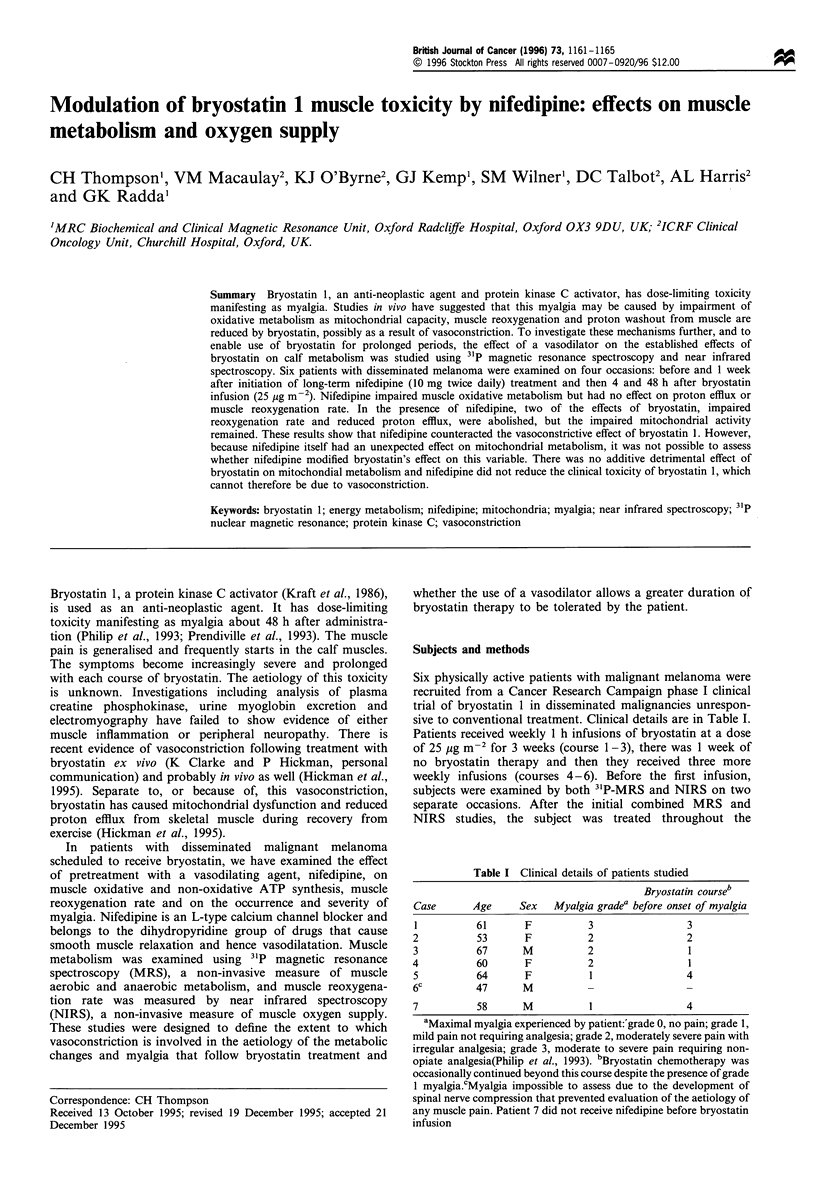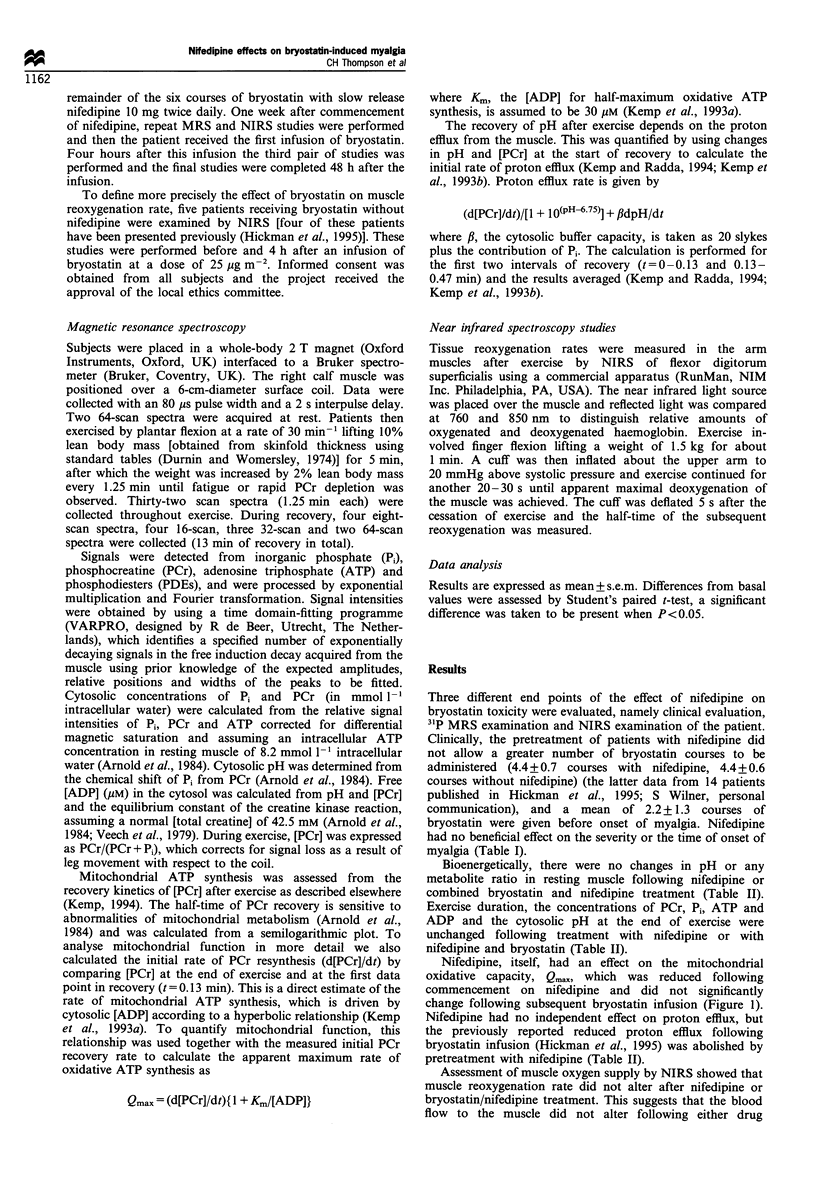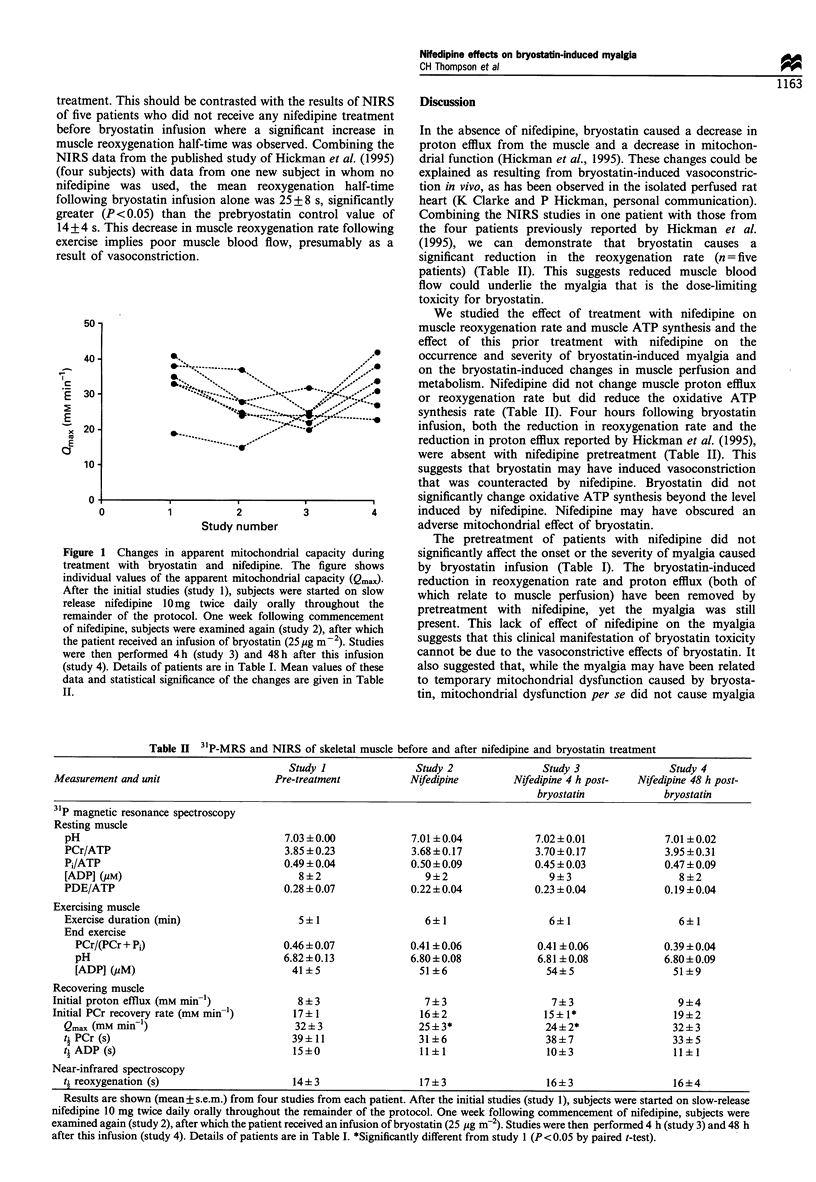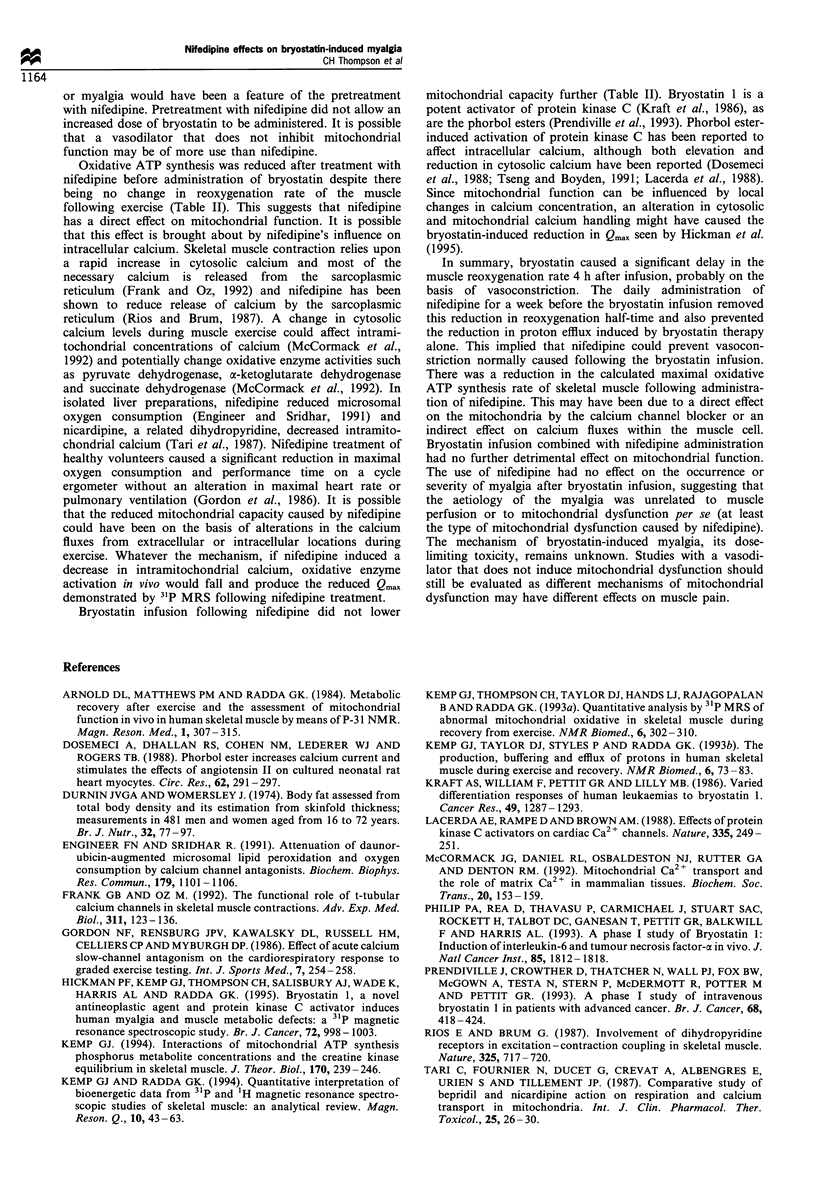Abstract
Bryostatin 1, an anti-neoplastic agent and protein kinase C activator, has dose-limiting toxicity manifesting as myalgia. Studies in vivo have suggested that this myalgia may be caused by impairment of oxidative metabolism as mitochondrial capacity, muscle reoxygenation and proton washout from muscle are reduced by bryostatin, possibly as a result of vasoconstriction. To investigate these mechanisms further, and to enable use of bryostatin for prolonged periods, the effect of a vasodilator on the established effects of bryostatin on calf metabolism was studied using 31P magnetic resonance spectroscopy and near infrared spectroscopy. Six patients with disseminated melanoma were examined on four occasions: before and 1 week after initiation of long-term nifedipine (10 mg twice daily) treatment and then 4 and 48 h after bryostatin infusion (25 micrograms m(-2)). Nifedipine impaired muscle oxidative metabolism but had no effect on proton efflux or muscle reoxygenation rate. In the presence of nifedipine, two of the effects of bryostatin, impaired reoxygenation rate and reduced proton efflux, were abolished, but the impaired mitochondrial activity remained. These results show that nifedipine counteracted the vasoconstrictive effect of bryostatin 1. However, because nifedipine itself had an unexpected effect on mitochondrial metabolism, it was not possible to assess whether nifedipine modified bryostatin's effect on this variable. There was no additive detrimental effect of bryostatin on mitochondrial metabolism and nifedipine did not reduce the clinical toxicity of bryostatin 1, which cannot therefore be due to vasoconstriction.
Full text
PDF




Selected References
These references are in PubMed. This may not be the complete list of references from this article.
- Arnold D. L., Matthews P. M., Radda G. K. Metabolic recovery after exercise and the assessment of mitochondrial function in vivo in human skeletal muscle by means of 31P NMR. Magn Reson Med. 1984 Sep;1(3):307–315. doi: 10.1002/mrm.1910010303. [DOI] [PubMed] [Google Scholar]
- Durnin J. V., Womersley J. Body fat assessed from total body density and its estimation from skinfold thickness: measurements on 481 men and women aged from 16 to 72 years. Br J Nutr. 1974 Jul;32(1):77–97. doi: 10.1079/bjn19740060. [DOI] [PubMed] [Google Scholar]
- Engineer F. N., Sridhar R. Attenuation of daunorubicin-augmented microsomal lipid peroxidation and oxygen consumption by calcium channel antagonists. Biochem Biophys Res Commun. 1991 Sep 16;179(2):1101–1106. doi: 10.1016/0006-291x(91)91933-4. [DOI] [PubMed] [Google Scholar]
- Frank G. B., Oz M. The functional role of t-tubular calcium channels in skeletal muscle contractions. Adv Exp Med Biol. 1992;311:123–136. doi: 10.1007/978-1-4615-3362-7_9. [DOI] [PubMed] [Google Scholar]
- Gordon N. F., van Rensburg J. P., Kawalsky D. L., Russell H. M., Celliers C. P., Myburgh D. P. Effect of acute calcium slow-channel antagonism on the cardiorespiratory response to graded exercise testing. Int J Sports Med. 1986 Oct;7(5):254–258. doi: 10.1055/s-2008-1025770. [DOI] [PubMed] [Google Scholar]
- Hickman P. F., Kemp G. J., Thompson C. H., Salisbury A. J., Wade K., Harris A. L., Radda G. K. Bryostatin 1, a novel antineoplastic agent and protein kinase C activator, induces human myalgia and muscle metabolic defects: a 31P magnetic resonance spectroscopic study. Br J Cancer. 1995 Oct;72(4):998–1003. doi: 10.1038/bjc.1995.449. [DOI] [PMC free article] [PubMed] [Google Scholar]
- Kemp G. J. Interactions of mitochondrial ATP synthesis and the creatine kinase equilibrium in skeletal muscle. J Theor Biol. 1994 Oct 7;170(3):239–246. doi: 10.1006/jtbi.1994.1184. [DOI] [PubMed] [Google Scholar]
- Kemp G. J., Radda G. K. Quantitative interpretation of bioenergetic data from 31P and 1H magnetic resonance spectroscopic studies of skeletal muscle: an analytical review. Magn Reson Q. 1994 Mar;10(1):43–63. [PubMed] [Google Scholar]
- Kemp G. J., Taylor D. J., Styles P., Radda G. K. The production, buffering and efflux of protons in human skeletal muscle during exercise and recovery. NMR Biomed. 1993 Jan-Feb;6(1):73–83. doi: 10.1002/nbm.1940060112. [DOI] [PubMed] [Google Scholar]
- Kemp G. J., Taylor D. J., Thompson C. H., Hands L. J., Rajagopalan B., Styles P., Radda G. K. Quantitative analysis by 31P magnetic resonance spectroscopy of abnormal mitochondrial oxidation in skeletal muscle during recovery from exercise. NMR Biomed. 1993 Sep-Oct;6(5):302–310. doi: 10.1002/nbm.1940060504. [DOI] [PubMed] [Google Scholar]
- Kraft A. S., William F., Pettit G. R., Lilly M. B. Varied differentiation responses of human leukemias to bryostatin 1. Cancer Res. 1989 Mar 1;49(5):1287–1293. [PubMed] [Google Scholar]
- Lacerda A. E., Rampe D., Brown A. M. Effects of protein kinase C activators on cardiac Ca2+ channels. Nature. 1988 Sep 15;335(6187):249–251. doi: 10.1038/335249a0. [DOI] [PubMed] [Google Scholar]
- McCormack J. G., Daniel R. L., Osbaldeston N. J., Rutter G. A., Denton R. M. Mitochondrial Ca2+ transport and the role of matrix Ca2+ in mammalian tissues. Biochem Soc Trans. 1992 Feb;20(1):153–159. doi: 10.1042/bst0200153. [DOI] [PubMed] [Google Scholar]
- Philip P. A., Rea D., Thavasu P., Carmichael J., Stuart N. S., Rockett H., Talbot D. C., Ganesan T., Pettit G. R., Balkwill F. Phase I study of bryostatin 1: assessment of interleukin 6 and tumor necrosis factor alpha induction in vivo. The Cancer Research Campaign Phase I Committee. J Natl Cancer Inst. 1993 Nov 17;85(22):1812–1818. doi: 10.1093/jnci/85.22.1812. [DOI] [PubMed] [Google Scholar]
- Prendiville J., Crowther D., Thatcher N., Woll P. J., Fox B. W., McGown A., Testa N., Stern P., McDermott R., Potter M. A phase I study of intravenous bryostatin 1 in patients with advanced cancer. Br J Cancer. 1993 Aug;68(2):418–424. doi: 10.1038/bjc.1993.352. [DOI] [PMC free article] [PubMed] [Google Scholar]
- Rios E., Brum G. Involvement of dihydropyridine receptors in excitation-contraction coupling in skeletal muscle. Nature. 1987 Feb 19;325(6106):717–720. doi: 10.1038/325717a0. [DOI] [PubMed] [Google Scholar]
- Tari C., Fournier N., Ducet G., Crevat A., Albengres E., Urien S., Tillement J. P. Comparative study of bepridil and nicardipine action on respiration and calcium transport in mitochondria. Int J Clin Pharmacol Ther Toxicol. 1987 Jan;25(1):26–30. [PubMed] [Google Scholar]
- Tseng G. N., Boyden P. A. Different effects of intracellular Ca and protein kinase C on cardiac T and L Ca currents. Am J Physiol. 1991 Aug;261(2 Pt 2):H364–H379. doi: 10.1152/ajpheart.1991.261.2.H364. [DOI] [PubMed] [Google Scholar]
- Veech R. L., Lawson J. W., Cornell N. W., Krebs H. A. Cytosolic phosphorylation potential. J Biol Chem. 1979 Jul 25;254(14):6538–6547. [PubMed] [Google Scholar]


